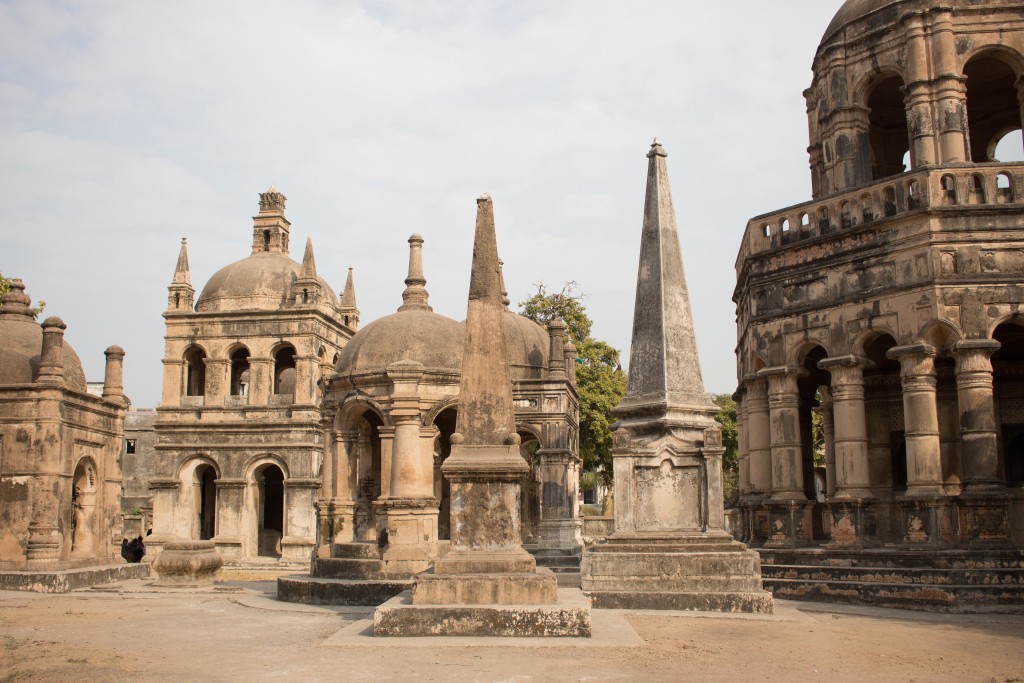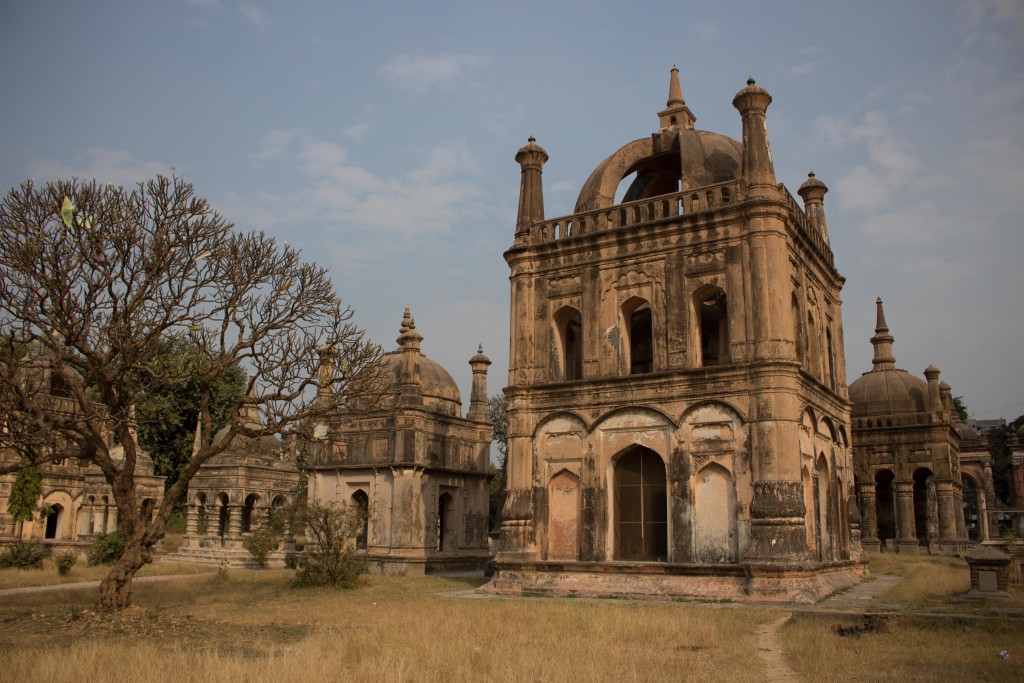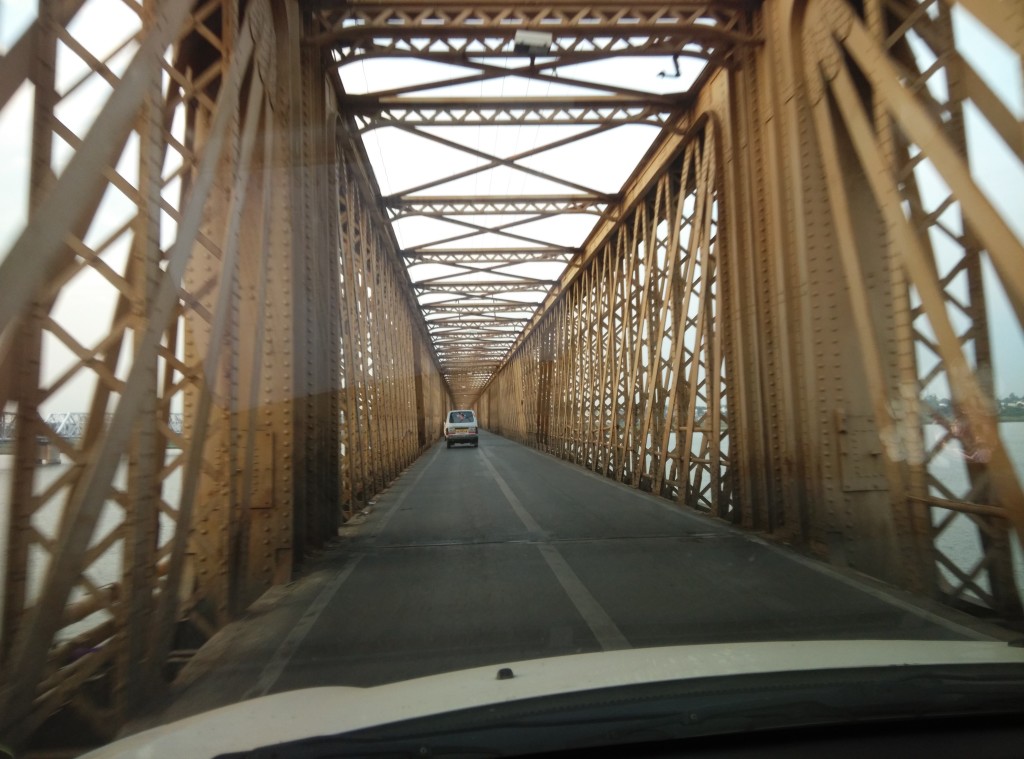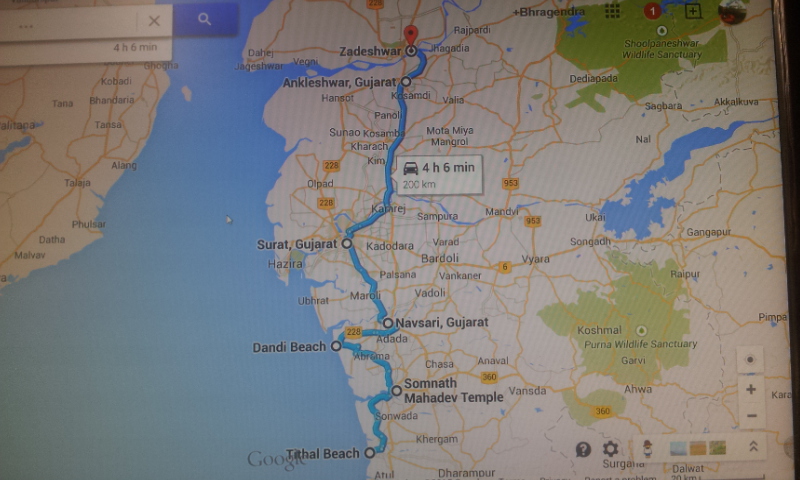Gujarat Tour Diary: Day 04 |Dandi Salt March to Tata’s birth place
(If you have come to this page while searching for some travel related information of Gujarat, I suggest you start from Day 0 of this travelogue.)
It was our first morning in Gujarat. At the time of sunrise, the clock will show around 4.30 am in Arunachal Pradesh. However, here it shows around 7.10 am. That is the difference from our eastern border to western border.
We thought of having the breakfast in the guest house. After the morning Aarati, the breakfast was served. We, the South Indians, can adjust to Gujarati meals easily. But it is quite difficult to adjust to the typical Gujarati breakfast. It is all deep fried items like Bajji, Pakoda, Vada, Chilli etc. As something is better than nothing, and as we didn’t want to waste some more time in search of breakfast, we finished the same and left.
The first place for the day was near Billimora.
- Somnath Mahadev Temple: It is situated on the banks of Ambika River in Billimora city of Navsari district. It is a temple of Lord Shiva. It is the tallest (108 feet) Mahadev temple in south Gujarat.


Next place on our list was Dandi.
- Dandi Beach and Dandi: {The Salt marshes of Dandi were the site for one of the most important events in India’s Independence Movement. In 1930, Mahatma Gandhi undertook the Salt Satyagraha protesting against the British salt laws. He walked from Ahmedabad with a group of followers that kept growing at each stage of his protest march. At Dandi, he plucked a handful of saline mud and seawater, producing salt in protest against the British monopoly on salt production. This simple act got much national support and is credited with breaking the back of the Raj in India.
- The Government of India initiated plans to develop the Sabarmati-Dandi stretch as a tourist hub. The government has also preserved the building where Mahatma stayed, as memorial to commemorate the Salt March of the Indian Independence Movement. source: wikipedia}
Don’t search for any memorabilia in the Dandi Beach. Actually the Beach is not the place where Mahatma produced salt. That place is almost 1.5 kms before the beach. And it is a perfect land. There is no trace of sea water at the very place where Mahatma produced salt. I don’t know how it was possible; but digging such details was not my intention. There is a house where Mahatma stayed. The whole place is converted into a sort of museum.




We saw this opposite to the Gandhi Memorial Museum. Can you tell me whether this peacock is real or is it a statue?
Navsari
From Dandi we proceeded to Navsari district headquarters. It is always a pain to enter into the city limits. The traffic is choc-a-block. The roads are congested and difficult to find a parking place. With great difficulty we were able to park our car and locate the Jain temple.
- Shri Chintamani Parshwanath Temple: It is the famous Jain pilgrimage in the district of 23rd Lord (Tirthankar) Of Jains – Parshvanath. Many pilgrims go there regularly for worshiping God.

- Tata’s birth place: The pioneer of the Indian industry, founder of the House of Tata’s, Mr. Jamshedji Tata was born in Navsari. The house where he was born is well preserved. This is very close to Parshwanath Temple. As this is not mentioned in Maps, we had a tough time in locating it. But once we were there, let me tell you, our effort was worth it. The house is well preserved.
I am an admirer of Tatas. They are one of the greatest patriots of our motherland. They are pioneers of Indian industries. And “Tata” is a highly respected brand globally.



From Navsari, we went to Surat. As we were nearing Surat, we could see the air pollution around the city. The outskirts of the city was filled with lots of industries and the air was heavily polluted. Just be careful, in case if you are allergic to this type of pollution.
Surat
{Surat lies on the banks of the River Tapti. Earlier it used to be one of the chief ports of western India. There are evidences that this port served as a gateway to Gujarat. Surat is famous for its diamond and textile industries. It is very famous for its cotton mills too. Surat is the biggest centre of MMF (man-made fibre) in India.
The city accounts for:
90% of the world’s total rough diamond cutting and polishing;
99.99% of the nation’s total rough diamond cutting and polishing;
90% of the nation’s total diamond exports;
40% of the nation’s total man made fabric production;
28% of the nation’s total man made fibre production;
18% of the nation’s total man made fibre export;
12% of the nation’s total fabric production.
Diamond Industry: Around the world, 8 out of 10 diamonds on the market were cut and polished in Surat. This industry earns India about 10 billion USD in annual exports. A legacy of Old Dutch trade links, it began after a Surti entrepreneur returned from East Africa bringing diamond cutters. The rough diamonds themselves, however, come to Surat as rough crystals ripped out mainly from deep under the earth of South Africa and other regions of the continent, and go from here as smooth gems to Antwerp, Belgium where the international diamond trade is run mainly by Hasidic Jews and Jains from Palanpur in North Gujarat.
Diamond Jewelry: There are a number of private jewelry stores in the city.
Textiles: The city is home to several textile markets. Surat has a Biggest Sari & Dress market.
Textile Markets: South of the Sahara Gate which opens on to Bardoli Road, the textile markets are packed with saris, salwar kameez, dress pieces, and a range of other polyester, silk, printed, and embroidered materials that Surat, once renowned for silk weaving and brocade, and is still famous for even after a history of setbacks in the textile industry.
Clothing: G3 Store is a fashionable boutique. The store has high quality eastern and western clothing at reasonable prices. Keep your eyes open and you may stumble across designer brands with European labels – These may be overruns from the local textile industry
Shopping Plazas: There are lots of such Malls mushrooming in the city. Iscon Mall, Rahul Raj Mall, Central Mall, VR Mall are some best known shopping mall in Surat; source: wikipedia}
Those are some details about Surat from the internet.
We are not shopaholics; and the time was more specious for us than visiting these shopping places. So we skipped all the shopping lists and went in search of the tourist places.
Now, one by one, the places we tried to see and were able to see.
- Gopi Talav and Nav Sa’id Mosque: {This Lake is named after Gopi, credited with the rise of the city. Nav Sa’id Masjid is one of the 4 main mosques, along with Khudawand Masjid, Sayyid Idris Mosque & Khwaja Diwan Sahib. source: wikipedia}.
- We tried our level best in the busy city traffic to locate it. Maps was showing its location but we were not able to locate the same.
- Ambika Niketan Temple: {Ambika Niketan Temple is one of the popular pilgrim spots in Surat. It is situated on the banks of River Tapti & was built in 1969. The temple is dedicated to Mother Goddess, who is in the form of Goddess Ashtabhuja Ambika. There are also shrines dedicated to Ram-Sita, Laxminarayan and Lord Shiva at Ambika Niketan Temple. source: wikipedia}.
- After the unsuccessful chase of Gopi Talav, we went take the blessings of Maata Ambika. As Maata wanted to show her face to us, we were able to reach the temple just a few seconds before its closing. It is a nice one and don’t miss it.
It was time for lunch. Parking our car was also a big problem as it is a crowded city with heavy traffic. After the lunch, we headed towards Dutch Garden.
- Dutch Garden: {Dutch Garden is a major attraction of Surat city}.
- Don’t trust these words from the net. It is just a waste of time.
- Surat castle (Old Fort): {This historical castle, which was planned and built between 1540 and 1546 by Khudawand Khan, is one of the chief ancient monuments of Surat. It is built on the bank of river Tapi. The highest degree of safety from defence point of view is conspicuously incorporated in the construction of its entrance gate also. This magnificent gateway is so designed as to provide a massive structure having strong door shutters furnished with protruding spikes at the exterior facade, and a decorative architectural treatment at the interior Façade. source: wikipedia}.
- Again, there is nothing much to talk about this fort.
- Chintamani Jain Temple: {The exquisite wooden carvings and paintings are the major attractions. It is situated in the Shahpor area and dates back to 15 century and houses some extremely rare paintings of the Jain monk Acharya Hemachandra, and of the Solanki King Kumarpal. Any visit to the city would be incomplete without a visit here especially for Jains}.
As we did not want to manoeuvre the heavy city traffic, we skipped this place.
- Dutch Cemetery: {Located near Kataragam Gate, this impressive mausoleum is that of Baron Hendrik, who died in 1691. A massive Dome, beautiful pillars and huge gallery make it very outstanding monument. source: wikipedia}.
- Can a cemetery be a tourist place? Yes, believe me. But, most of the Surat localites might not have seen this place. It is a bit inside the main road but locating was not a problem because of Maps. There will not be any visitors here. But it is worth a visit.

- European Tombs or English Cemetery: {It is said that the competition between the Dutch and the British followed them even past death. They erected grand mausoleums, heavily influenced by Hindu and Islamic elements. Next door to the British and Dutch cemeteries is the churchyard of the Armenians, whose tombstones are heavily inscribed, but forgo the superstructures of the other two communities. The cemeteries have been declared as protected monuments, but they still show signs of deterioration, both from natural weathering and from human visitors. source: wikipedia}.
As this place is also very close to the Dutch cemetery, we went there. Again, we were not disappointed. It took us just 5 minutes to have a look at this place.
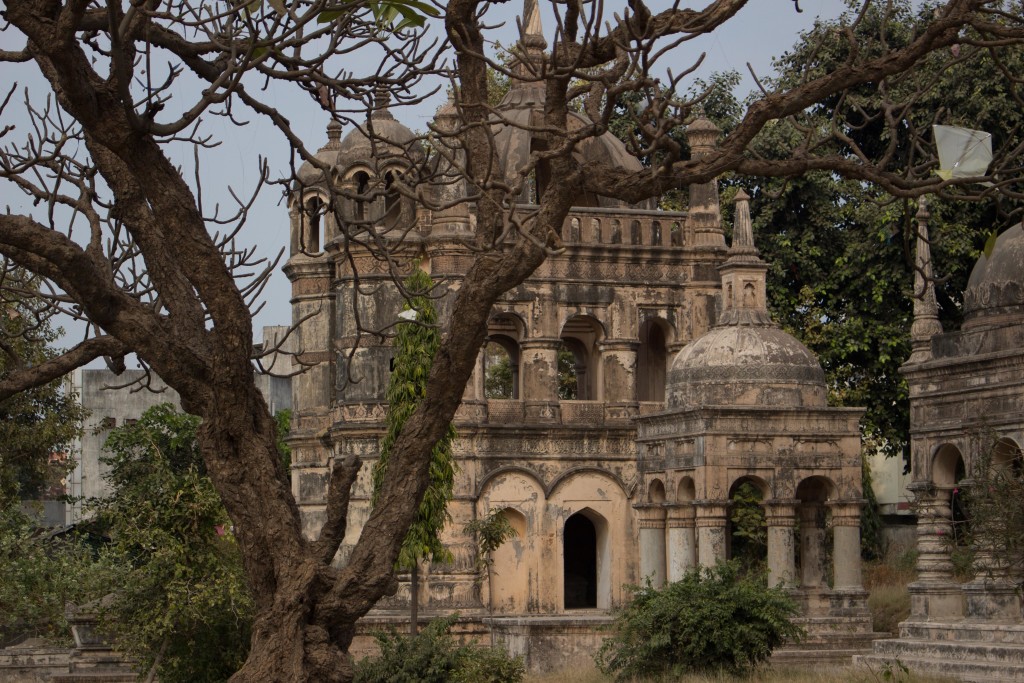
- Swami Narayan Temple: {Temple is constructed with marble, near bank of river Tapti, where one can have peace of mind within the temple}.
We skipped this place, because of time constraint.
- Hazira: {Hazira is a health resort, beach and a Port. Hazira has two wells with water rich in iron and sulphur. The pleasant Hazira beach is fringed by feathery casurina trees. It is situated 28 kms from Surat and has a comfortable holiday home for visitors. source: wikipedia}.
Again, we skipped this place, because of time constraint.
So all in all, we were of the opinion that there is not much to explore in Surat unless you are interested in shopping.
Bharuch
{Bharuch is a City at the mouth of the river Narmada. According to the Skanda Purana, the sage Bhrigu came to Bharuch sitting on a tortoise. In ancient India, Bharuch was an important trading port with merchants from the Arabian Peninsula using this port for trading with the lucrative Indian market. The salty Peanuts of Bharuch are world famous, so don’t forget to buy some. source: wikipedia}.
From Surat we went towards Bharuch city. The first place on our list was Ankleshwar.
- Ankleshwar: {Situated at a distance of 12 km south of Bharuch, it is also an ancient city. Important places here include Antarnath Mahadev, Gayatri Mandir and Ram Kund. Today Ankleshwar is a highly industrialized city and it has the honor of being the biggest Industrial Complex in whole of Asia. It has over 5000 big and small chemical plants, which produce products such as pesticides, pharmaceuticals, specialty chemicals, and paint. source: wikipedia}.
- There are a couple of tourist places in Ankleshwar. But for us, it looked more like an industrial estate, something like Peenya Industrial Estate in Bengaluru. So we passed through Ankaleshwar and went to Bharuch city through old NH8.
Just before entering the Bharuch city through Old NH8, we get this marvelous Golden Bridge across Narmada River.
- The Golden Bridge: {It was built by the British in 1881 across the Narmada River to improve access to traders and administrators to Bombay. The structure was built with rust-resistant iron, and therefore, more expensive than modern steel, lending to the name Golden Bridge. This bridge connects Bharuch and Ankleshwar. source: wikipedia}.
Remember, the traffic between Ankleshwar and Bharuch on this Old NH8 is heavy. And I think only light vehicles are allowed, as the width of the bridge is not much. There can be traffic jams quite often. Keep this in mind when you drive in this road.
And it is a marvelous bridge. If you happen to be somewhere nearby, don’t miss this bridge. After all, why only Howarh Bridge must be famous, and why not the Golden Bridge?

And this Howrah Bridge photo is from my archives:
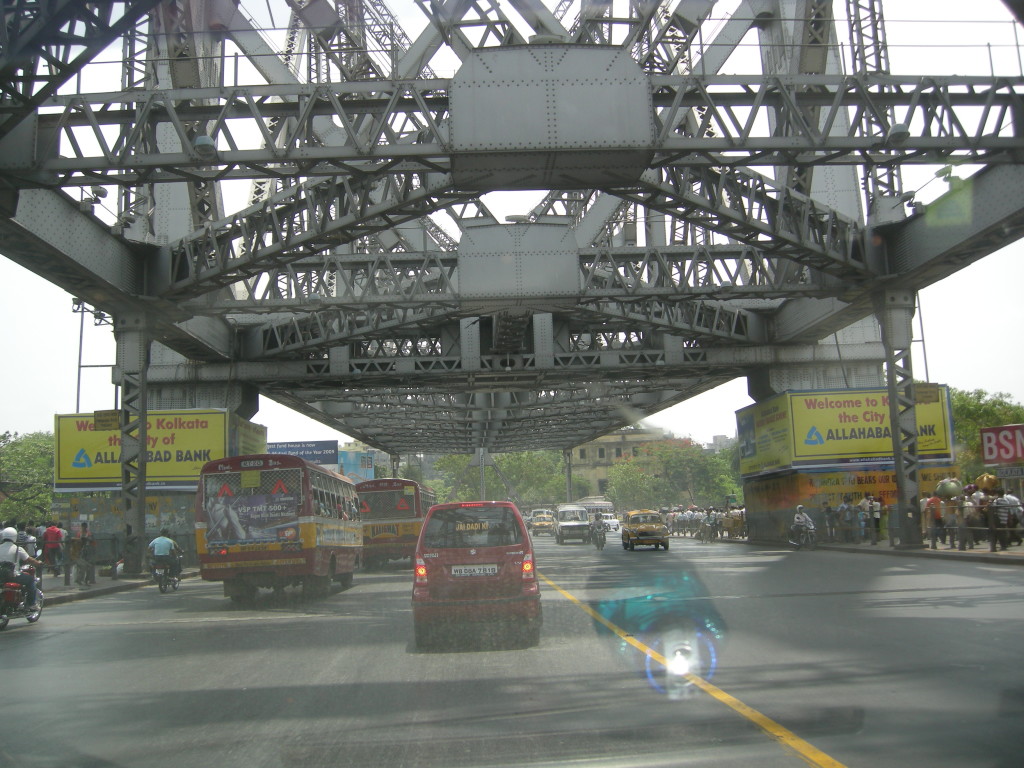
After taking the photos, Maps told us that the Gurudwara is also very close by. So we parked our vehicle on the road side and walked up to the Gurudwara.
Gurudwara Chadar Saheb: {In the 15th century, the first Sikh Guru – Guru Nanak Dev visited Bharuch. When a boatman refuses to take him across the Narmada, he crosses over on a cloth sheet or chadar. The Gurudwara was later constructed on the site where he landed in Bharuch. source: wikipedia}.
This Gurudwara is quite visible from the Golden Bridge, if you carefully observe. As usual, there is a Langar in this Gurudwara also. (No one can match Sikhs in hospitality in Langars. I have seen and eaten their food at many places – Amarnath yatra, Hemkund Saheb, Amritsar, Nanded etc). True to their style, we were offered food. But as it was an odd time, we just had a cup of tea and proceed further.
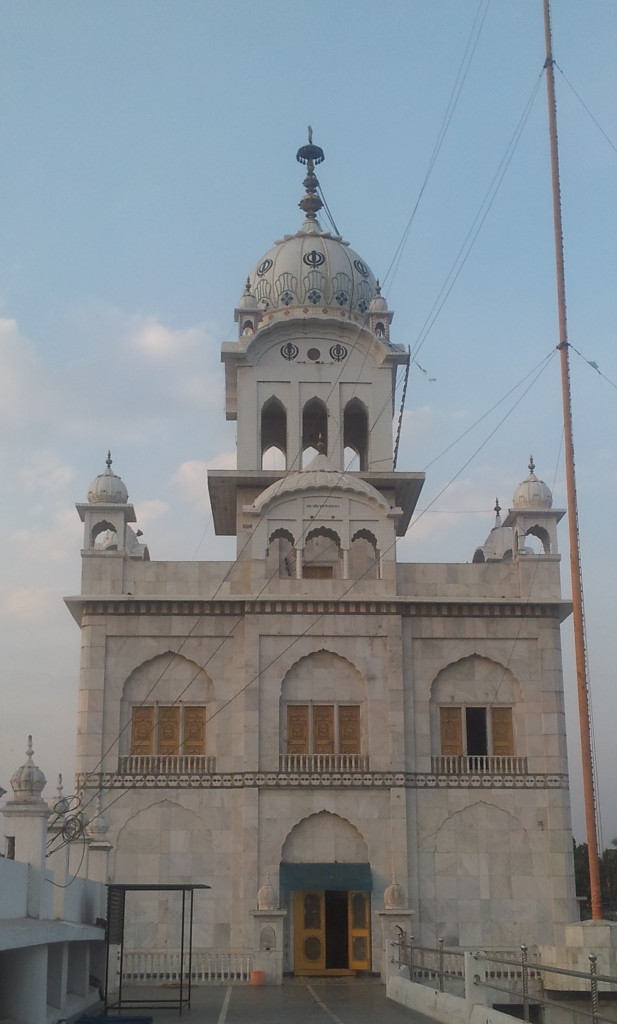

Down the Narmada River, there are some important places that we saw.
- Bhrigu Rishi Temple: {The temple of Bhrigu Rishi, one of the famous and sacred temples of Gujarat, is situated on the east of the city in Dandia Bazar area on the banks of the holy river Narmada. This temple, being visited by a number of pilgrims, has great religious importance to the people of Bharuch. Bharuch which was originally called ‘Bhrigukachchha’ derived its name from this temple. It was here that Bhrigu Rishi wrote first Indian Astrological work, Bhrigu Samhita. He is said to have documented five million horoscopes, in which he wrote down the fate of every being in the universe. source: wikipedia}.
Personally I wanted to see this temple at any cost. The name given to me by my parents is “Bhrigendra”, which is derived from Bhrigu Rishi. And I had never come across a temple of this Rishi. It was evening, the Sun has already set. So we hurried a bit and fortunately we were able to see the temple.


- Dashashwamedh Ghat: {A dip in the Narmada washes ones sins away. Many ghats are situated on the banks of Narmada in Bharuch, which hosts a number of temples also. Dashashwamedh ghat is situated on the bank of Narmada near Dandia Bazar. This is the place where King Mahabali performed ten ashwamedha sacrifices. It is at this place where Lord Vishnu came in the disguise of Vamana and measured the whole universe with his three steps. One must not forget to visit this ghat at early morning hours to enjoy the spiritual peace of this place. source: wikipedia}.
- Other temples: {There are many old temples constructed on this ghat which includes Ambaji Mata Temple, Umiya Mata Temple, Narmada Mata Temple, Kotirudreshwar Mahadev, and Vamana Temple etc. The Swami Narayan Temple in Dandia Bazar area of city is 175 years old and hosts a palette of colour on its walls. Narmada Mata Temple, also in Dandia Bazar, is 150 years old and dedicated to Goddess Narmada. source: wikipedia}
- Lallubhai Haveli: {The fort of Lallubhai Haveli is perched on a hilltop. Below the hill, the Narmada River flows. Upstream of Bharuch, the Sardar Sarovar Dam can be spotted. The Haveli is a one-storied building. It has one room on the second floor. Lallubhai used to hold up meetings in the court here. The Haveli showcases beautiful architecture of richly designed carved wood. On the second floor of the building you can spot arrangements for placing matchlock guns. Lallubhai Haveli also has underground passages. It has underground passages which were the common feature of most of the traditional structures. source: wikipedia}
As it was getting dark, after visiting the Bhrigu Rishi Temple, we skipped all other places. We proceeded towards BAPS Swami Narayan Mandir.
- BAPS Swami Narayan Mandir: {Swami Narayan Mandir in Zadeshwar lies on the NH-8 and attracts a huge number of devotees from Bharuch and nearby areas. Swami Narayan sect is a modern tradition of Hinduism, in which followers offer devotion and worship Swami Narayan as the final manifestation of God. source: wikipedia}

This was our second day in Gujarat. It was nearing 7 pm. So first we had the Darshan of Swami Narayan and then we went to the reception. On request, we were given a room for the night. The room was more than what we had asked for. The food was also excellent. The only problem was that the Mandir guest house is adjacent to the NH8. And there is always heavy traffic jam. The continuous horn sound by the lorry traffic disturbed our sound sleep. But these are all part-and-parcel of any tour.
Total distance covered: 236 kms.
Read previous day’s account| Read next day’s account



